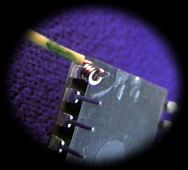 CIRCUITRY WITHOUT CIRCUIT BOARDS
CIRCUITRY WITHOUT CIRCUIT BOARDS
(This page is for Dennison - thanks for the question.)
The trick is an easy way to make a socket on the end of
24 guage copper wire. I use the wire 
 from multiple conductor telephone cable. It's readily available because
it is currently being replaced with fiber optic cable. It also provides
a source of rich color (for wire at least). As a rule, Ma Bell's wire is
not tinned but if you use clean stuff and solder carefully it works fine.
It doesn't hurt to use a little extra rosin flux on your solder joints,
and a thermal stripper is a good idea to protect against nicking the wire.
from multiple conductor telephone cable. It's readily available because
it is currently being replaced with fiber optic cable. It also provides
a source of rich color (for wire at least). As a rule, Ma Bell's wire is
not tinned but if you use clean stuff and solder carefully it works fine.
It doesn't hurt to use a little extra rosin flux on your solder joints,
and a thermal stripper is a good idea to protect against nicking the wire.
All you need is a pin vise that will hold a piece of 20ga(.032in)
spring wire:
 The slit in the vise jaws holds the copper wire, and about five turns around
the spring wire mandrel makes a perfect solder cup for a DIP pin. If you
build a computer this way, the prospect of wiring each pin can be daunting
and it takes some practice to get the rhythm of making the coil.
The slit in the vise jaws holds the copper wire, and about five turns around
the spring wire mandrel makes a perfect solder cup for a DIP pin. If you
build a computer this way, the prospect of wiring each pin can be daunting
and it takes some practice to get the rhythm of making the coil. 
My Grandmother used to make lace and it fascinated me
to see her doing this complicated series of knots while at the same time
carrying on a conversation and paying attention to all sorts of things.
She told me that she could see her mood in the finished lace. I think making
circuitry can be like making lace - given the right rhythm. NASA is probably
not interested in this kind of speculation.

The connection to the IC pin is strong and reliable, and
can be taken apart quite easily with a solder sucker. It's open to revision
at anytime.  By changing the mandrel in the pin vise you can make different size sockets
for all kinds of components, nodes, and splices. The insulation on the
wire melts quite easily, so solder carefully and quickly. If two wires
are pressing together near a solder joint it is possible that the insulation
will melt and cause a short that is very difficult to see, but easy to
avoid if you're vigilant.
By changing the mandrel in the pin vise you can make different size sockets
for all kinds of components, nodes, and splices. The insulation on the
wire melts quite easily, so solder carefully and quickly. If two wires
are pressing together near a solder joint it is possible that the insulation
will melt and cause a short that is very difficult to see, but easy to
avoid if you're vigilant.
Design engineers, with their characteristic tendency for
romantic metaphor, call this kind of wiring a 'rat's nest'. It's probably
not a useful way to make production electronics because S/N ratios are
not predictable with wire running all over the place.  Freedom from the circuit board grid does let you make your circuits in
any shape, and eliminates all the nasty etching chemistry. I have some
instruments built this way that have been working for more than twenty
years, so I can vouch for the method's reliability. I haven't done it,
but I think it could be interesting to see what happens when high-frequency
circuitry is wired this way.
Freedom from the circuit board grid does let you make your circuits in
any shape, and eliminates all the nasty etching chemistry. I have some
instruments built this way that have been working for more than twenty
years, so I can vouch for the method's reliability. I haven't done it,
but I think it could be interesting to see what happens when high-frequency
circuitry is wired this way.
A cork board makes a good base to work on. You can use thumb tacks and pins to hold things together for soldering, and I have found small bags of lead shot handy for weights to keep things in place.
 The circuitry gets to be like doileys (a new name for modular units) that
add together electronically; they're quite tough and easy to handle if
you make them carefully. Strategic binding and a drop of glue here and
there (acrylic medium works well) makes them even tougher, but remember
it is good to be able to take them apart.
The circuitry gets to be like doileys (a new name for modular units) that
add together electronically; they're quite tough and easy to handle if
you make them carefully. Strategic binding and a drop of glue here and
there (acrylic medium works well) makes them even tougher, but remember
it is good to be able to take them apart.
I would like to see the walls and ceiling of a whole room covered with functioning circuitry made this way. When you do it, please send me a picture.